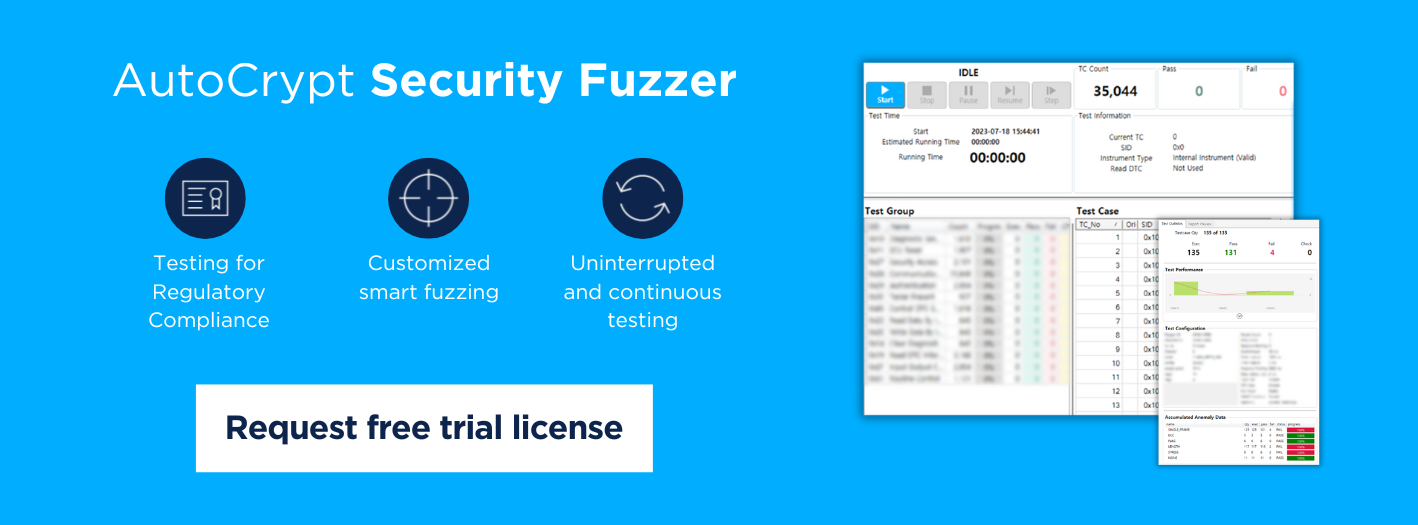Securing complex automotive systems from cybersecurity threats has become essential as connected and autonomous vehicles proliferate. The shift in the industry is mirrored by regulatory bodies enforcing cybersecurity measures across the board. As the standards for cybersecurity grow, fuzz testing has emerged as a powerful tool that helps manufacturers meet cybersecurity demands.
Traditional fuzz testing methods are often labor-intensive and struggle to keep pace with modern vehicles’ intricate software structures. Fortunately, cybersecurity testing technology has evolved in the past years. Advanced fuzzing techniques, like smart and automated fuzzing, are transforming automotive cybersecurity testing—reducing time-to-market, enhancing system resilience and overall vehicle safety, all while helping achieve regulatory compliance. This article will discuss the latest tools and technologies enabling smart automotive fuzz testing.
Overview of Fuzzing in Automotive Systems
As vehicles become more software-driven, their internal structures consisting of millions of lines of code are turning exponentially complex. That is why fuzz testing is essential for cybersecurity evaluation of automotive systems.
Fuzz testing, or fuzzing, is a cybersecurity technique where random or unexpected data is injected into a program to discover bugs, code discrepancies, and hidden vulnerabilities. Fuzzing helps uncover zero-day vulnerabilities that traditional testing methods may miss.
Challenges of Traditional Automotive Fuzz Testing
Despite its importance, traditional fuzz testing faces several challenges in the automotive sector.
Modern software-defined vehicles contain numerous interconnected systems, such as CAN, LIN, and Ethernet networks, that communicate with various sensors and external devices. This complexity makes it difficult to comprehensively assess the resilience of all vehicle components using a traditional fuzz test, resulting in incomplete coverage of potential vulnerabilities.
In addition, traditional fuzz testing often requires a manual process of inputting random data and observing system responses. This time-intensive approach requires round-the-clock labor and can delay development timelines, especially when testing complex systems where the number of test cases increases exponentially.
Smart Automotive Fuzzing: A Game Changer
Fortunately, vehicle cyber security testing tools have progressed with time and now incorporate advanced features like smart fuzzing. Smart automotive fuzzing is an innovative approach that leverages artificial intelligence (AI) and machine learning (ML) to make fuzz testing more efficient. This type of advanced testing uses data-driven methods to generate more targeted inputs, mixing and inputting test cases generated by multiple algorithms. This significantly improves test coverage while reducing the time required for testing.
AI-driven fuzzing tools use feedback mechanisms to learn from previous test iterations, adapting them to focus on high-risk areas of the system. For example, smart fuzzers record the outputs from previously conducted fuzz tests and use these results for subsequent rounds of test case generation. This ensures a more comprehensive assessment of critical vulnerabilities.
For instance, AutoCrypt Security Fuzzer uses a logical test case modeler to generate logic-based semi-random inputs tailored to the system being tested. The tool automates the creation of test cases based on the protocols and specifications of the target system. This ensures that only relevant test cases are generated, drastically reducing the need for manual intervention and saving valuable time. Employing an advanced judgment logic, the testing tool continuously monitors the vehicle system to detect failed cases.
Automatic ECU Status Recovery
One of the most time-consuming aspects of traditional fuzz testing is the need for manual system recovery after a failure or crash. Smart automotive fuzzing tools address this with automatic ECU status recovery, which allows for continuous system fuzzing.
Besides saving time, this feature helps minimize manual work during vulnerability testing, which consequently reduces operating expenses for manufacturers. Once a test target is selected, there is no need for manual input until fuzzing is complete. If a vulnerability or bug is detected, the system automatically records the issue and resets back to the original ECU status, continuing the fuzz testing process. For instance, the AutoCrypt Security Fuzzer automatically issues commands like “ECU reset” or “DTC clear” to restore the system to its original state.
Impact on Cybersecurity Testing and Regulatory Compliance
Employing smart automotive fuzzing tools accelerates and automates vehicle testing while maintaining thorough coverage of all components and ensuring comprehensive cyber security testing for regulatory compliance.
The ISO/SAE 21434 standard, for example, emphasizes the need for OEMs to integrate fuzz testing into their DevOps processes to ensure vehicle software security integrity. By automating fuzz testing, manufacturers can cover a wider range of potential vulnerabilities and comprehensively test the system against threats with minimum down time.
While UN R155 regulation does not specifically mandate vehicle fuzz testing, it emphasizes the importance of ensuring robust cybersecurity measures across vehicle software and embedded systems by requiring an automotive cybersecurity management system (CSMS).
To meet these requirements, OEMs and their suppliers must show that they have implemented rigorous risk assessment methods for uncovering vulnerabilities, which often includes fuzz testing as a practical approach. By using fuzz testing to stress-test vehicle components and communication protocols, manufacturers can better demonstrate that they have mitigated potential security risks in line with UN R155 guidelines.
Automated fuzzing provides a robust feedback mechanism that allows engineers to detect and address security gaps early in the development cycle. By doing so, manufacturers can improve vehicle safety while reducing the overall cost and complexity of software development.
Smart and automated fuzzing tools are revolutionizing the way manufacturers test and secure vehicle systems, making the process faster and more efficient. With innovations like AI-driven fuzzing and automatic ECU recovery, smart fuzz testing helps close security gaps while speeding up time-to-market.
Incorporating smart automotive fuzz testing into the development pipeline not only improves security but also ensures compliance with emerging regulations, making it a critical tool for the future of automotive cybersecurity. By embracing these advanced techniques, manufacturers can protect their vehicles—and their customers—against evolving cyber threats.
To see the AutoCrypt Security Fuzzer in action request a free trial license.
To learn more about AUTOCRYPT’s vehicle cybersecurity testing measures and cybersecurity regulation compliance consulting services, contact global@autocrypt.io.


